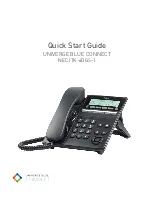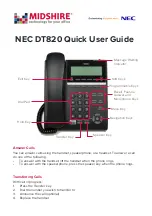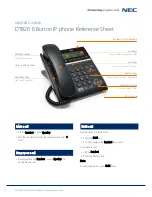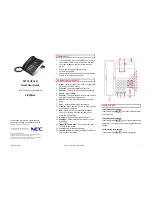
21
ET605 User Manual
Getting to Know Your Phone
Navigation keys
•
Confi rming, saving acti ons & input, and
returning to previous screen
•
Accepti ng calls on speakerphone and in
headset mode
•
From idle screen: Dialed calls (redial)
•
Canceling acti ons & input, and
returning to previous screen
•
Terminati ng calls on speakerphone and
in headset & handset modes
•
From idle screen:
Setti ngs menu
Select outgoing identi ty/account
•
In setti ngs, lists:
Navigate up
Navigate down
•
When editi ng:
Move cursor to the right
Move cursor to the left
Audio control keys
Adjusting the volume
◦ of the ringer when the phone is idle or ringing.
◦ of the handset/casing loudspeaker when in a call.
Mute/unmute the microphone.
Speakerphone.
◦ On idle: Press to dial number and accept calls on speakerphone.
◦ In call: Turn speakerphone on/off.
Headset.
◦ On idle: Press to dial number and accept calls on the headset.
◦ In call: Send audio to speakerphone, i.e. toggle between handset and handsfree mode.
Freely programmable function keys with LEDs
LED keys P1 and P2
. For more information, see "Configuring the function keys" on page 64. The default
setting is line.
◦ Fast-blinking LED: Incoming call. Press key or
to accept.
◦ Steadily lit LED: In call.
◦ Slow-blinking LED: Call on hold
Dedicated programmable function keys
The default settings are indicated by the symbol printed on the respective key.
Do not disturb mode (DND). Incoming calls do not ring; callers hear the busy signal.
Internal phone directory. For more info, see "Directories" on page 39
.
Transfer. Transferring active and ringing calls. For more info, see "Transferring calls" on page 56
.
Hold. Placing the active call on hold. For more info, see "Hold" on page 54
.
Message. Retrieving voice messages. For more info, see "MWI key" on page 24
.
















































